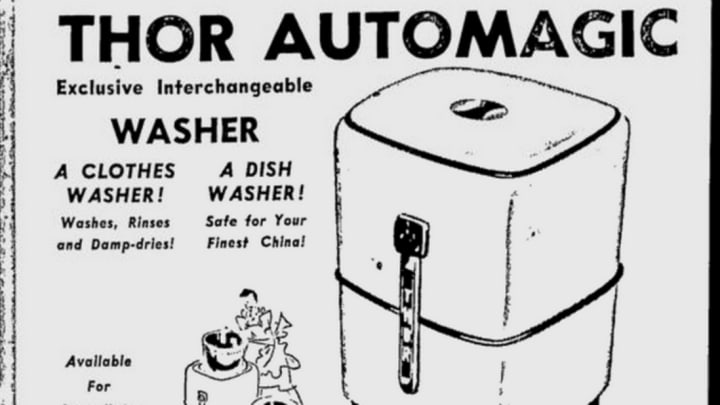In a just world, I would be able to clean my pants in a dishwasher. Despite the incredible technological advancements we've made in the past century, this still isn't possible. I can check my email in an airplane flying 35,000 feet over the ocean, but if want to throw a pair of khakis in with wine glasses after dinner I'm asking for too much all of a sudden.
When I brought up this idea to friends and co-workers, many expressed concern over dirty clothes contaminating dinnerware. Why? The desired end-result for both my laundry and my dirty dishes is the same: get clean. And as the old saying goes, "clean is clean" (that is not an old saying but let's keep moving here). Either way, were I to throw my pants in a consumer-grade dishwasher, they wouldn't come out clean as desired. Hard, slick materials like plates and glasses only require a spray and rinse, whereas soft fabrics need to soak and be agitated in order to remove the absorbed and ingrained grime. The two tasks also call for different types of detergents. Alas, my problem persists.
Wouldn't it be great if you only needed one machine? I'm not the first person to have thought this, for we all stand on the shoulders of giants.
In 1890, inventor Margaret A. Wilcox submitted a patent application for a combination clothes- and dishwasher (Shaunacy Ferro features the invention in this piece). It doesn't look as if the device, which relied on an air pump and hand crank for operation, ever made it to production, but Margaret A. Wilcox was a woman who got it. (Wilcox would later go on to achieve deserved recognition for inventing the first car heating system.)
After Wilcox's patent submission, it wasn't until the mid-1940s that the dream of a hybrid dishwasher and washing machine would come alive. That's when the Electric Household Utilities Corp. released their Thor Automagic combination clothes- and dishwasher, a machine that featured interchangeable tubs that could be swapped out depending on which items you were washing.
Here is a video showing a lucky Automagic owner testing out both features in a refurbished model:
A paragon of versatility! Why doesn't every home in America feature this beautiful, indiscriminate cleaning cube? Take my money, Electric Household Utilities Corp., take it now!
Even though it didn't allow you to wash dishes and clothes in one giant clump (as is my ultimate dream), it's still an ingenious and space-saving idea. I currently don't own a dishwasher or a washing machine, but were this to still exist, I could knock both purchases out in one fell—and economically smart—swoop.
According to the man who refurbished the Automagic featured in this video (a 1955 version of the machine—one of its last years in production), it had "just one wash speed," which provided "a gentle agitation." The video doesn't demonstrate the Automagic's dishwashing tub attachment (it's "off to be re-galvanized"), but he assures it's "very ingenious ... you will never cross-contaminate wash and dishwash water, all held in separate tubs!!"
He's not the only one excited about the Automagic. A commenter recalls, "I grew up with one of these ... We were a family of nine so my poor Mum really needed it. I have just written a poem about it! On firework night the rabbits and guinea pigs were put in the drum (no water and switched off—natch) to save them from being frightened by the bangs!" If that isn't the loveliest remembrance of a home appliance you have ever read, please send me the lovelier ones ASAP.
When asked if this would be a viable machine today, Roy Berendsohn, the Senior Home Editor at Popular Mechanics, doesn't sound as impressed. “Combining these two appliances, I think you’ll probably end up with a machine that does one function well and the other poorly or both poorly,” he says. “It seems unlikely that you’d produce a machine that does both well. Not to mention a machine that does both well and meets the energy-saving and water-conserving standards that modern (separate) appliances do.”
It’s true, modern dishwashers only use about six gallons per cycle, whereas a washing machine will use around 40 gallons for a full load. Any water-saving benefits would likely be lost due to the unique requirements of each task.
“Besides, what would you do if you want to wash dishes and do laundry at the same time?” Berendsohn adds. “Busy people would have little patience for swapping out tubs to handle these routine chores.”

The precise reason the Thor Automagic faded from marketplace relevancy isn't entirely clear, but its fall can be tracked as advertisements for the appliance stopped appearing in magazines in the early 1950s. Some of the last places where you'll find evidence of the Electric Household Utilities Corp. or Thor are in various directories of obsolete securities.
An inglorious end for such an ingenious product. It may not have been perfect, but at least it tried. If the day ever comes when we can proudly throw our pants into the dishwasher, we'll be able to look back and give thanks to the clever Automagic.
